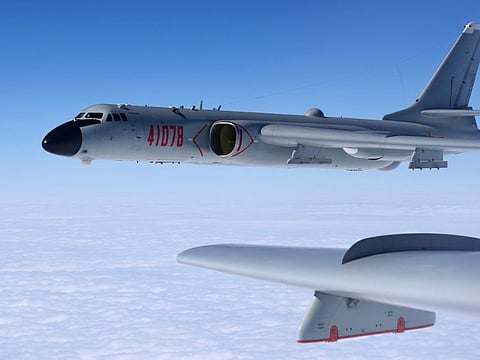China test-fires missiles in military drills around Taiwan
Asean foreign ministers urge ‘maximum restraint’

China’s military fired missiles into the sea on Thursday in live-fire military exercises around the island in response to US House Speaker Nancy Pelosi’s visit, even as Taipei played down the impact on flights and shipping.
China tested several Dongfeng missiles northeast and southwest of Taiwan from 13:56 pm local time, according to a statement from the island’s Defense Ministry. Sun Li-fang, a ministry spokesman, said the missiles were fired from land and they hit the sea.
China separately said the missiles accurately hit targets in seas east of Taiwan. The statement by the Eastern Military Command of the People’s Liberation Army said it had completed the drills, and that it had lifted air and sea controls.
The statement didn’t clarify whether that meant all military exercises had ended in six exclusion zones surrounding the island, which began at noon on Thursday and were set to last for 72 hours. At a regular briefing Thursday, Foreign Ministry spokeswoman Hua Chunying said she didn’t have information on whether all the drills had ended, and referred reporters back to the original Aug. 4-7 timeframe.
China earlier this week warned airlines to avoid “danger zones” around Taiwan after it announced its most provocative drills in decades in response to Pelosi’s visit, including missile tests and live-fire exercises. The No. 3 American official vowed Wednesday during a meeting with President Tsai Ing-wen in Taipei that the US wouldn’t abandon Taiwan.
The Taiwanese Defence Ministry said earlier it continues to be on high alert in response to the exercises, which the agency criticised as an attempt to undermine regional stability. Taiwanese Transportation Minister Wang Kwo-tsai said flights could use alternative air routes via Japan and the Philippines until the drills ended Sunday, while ships would be able to avoid the six exclusion zones.
“Shipping is different from air traffic as there is no fixed route - it’s freer,” Wang told reporters at a briefing late Wednesday. “So what’s done in the past is to avoid the areas where drills will take place.”
Chinese President Xi Jinping is under pressure to give a strong response to the trip, particularly after some local nationalists were disappointed that Beijing wasn’t able to deter Pelosi from visiting. She left Taiwan on Wednesday and is holding meetings in South Korea on Thursday before heading next to Japan.
Separately, Southeast Asian foreign ministers urged “maximum restraint” in a statement released during an annual meeting Thursday in Cambodia. Association of Southeast Asian Nations envoys expressed concern that developments “could destabilise the region and eventually could lead to miscalculation, serious confrontation, open conflicts and unpredictable consequences among major powers,” without naming China, Taiwan or the US.
On Wednesday, 27 Chinese military aircraft were detected in the skies around Taiwan’s airspace, with 22 crossing the median line of the Taiwan Strait - the most since the island began making the manoeuvres public in 2020. Separately, Taiwan said it warned off Chinese military drones flying near its Kinmen and Beiding islands - both of which sit close to the coastal Chinese city of Xiamen - Wednesday night.
China’s national security agency separately detained a Taiwanese man for long-time advocacy of Taiwan independence and founding a Taiwan Nationalist Party, state broadcaster CCTV on Wednesday. Beijing has also announced some trade restrictions on Taiwan.
Sign up for the Daily Briefing
Get the latest news and updates straight to your inbox







